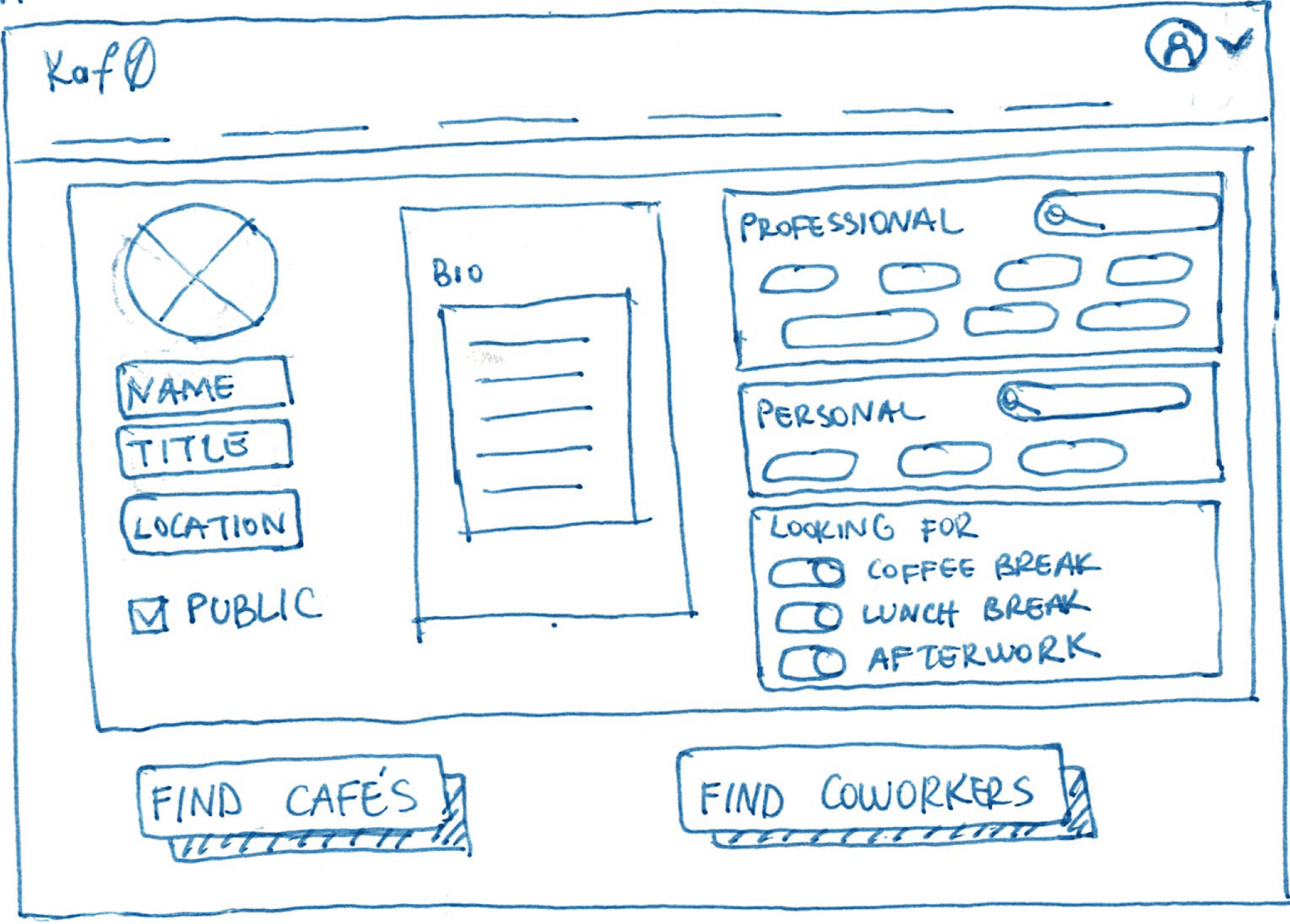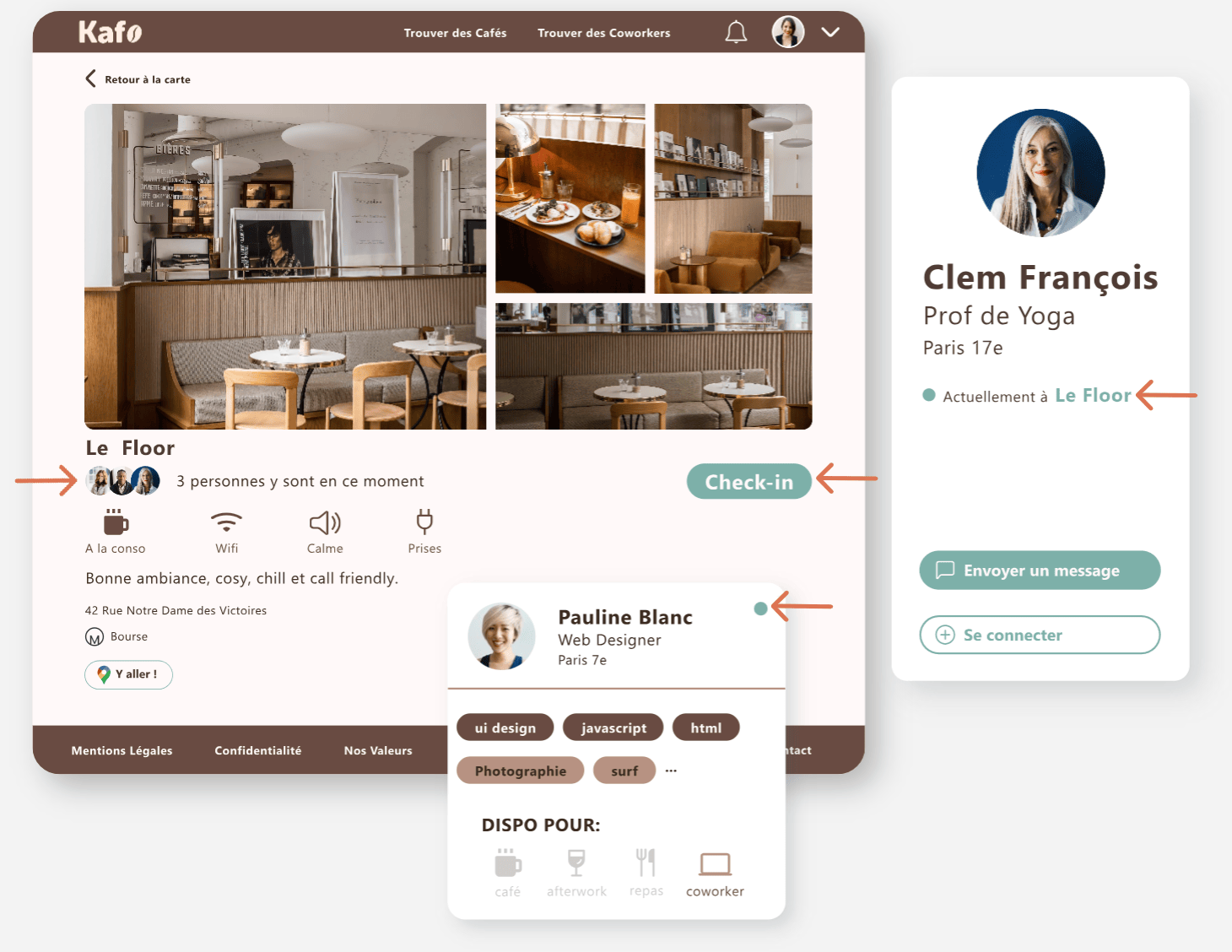
Kafo: Connecting remote workers
How might we create
opportunities for people working independently to cultivate meaningful connections, reintroducing
a sense of socialization and community into their workdays?

User Experience Design
User Research
User Interface Design
CLIENT
Kafo, a Paris-based start-up (hence the project outcome presented here is in French)
SCOPE
Two-week design sprint. 2 designers & 3 stakeholders
MY ROLE
In a team of two, I took the lead on working closely with the stakeholders to ensure we aligned with their project requirements. I collaborated with my teammate on the end-to-end design process from defining the project's goal, performing user research and producing a hi-fi prototype.
TOOLS
Figma, Figjam, Trello, Canva, Discord, Zoom
PROJECT CONTEXT
Kafo is a Parisian start-up whose platform currently includes a map-directory of all the great cafés to work in in the city. However, their main goal is not just to help freelances and remote workers find a place to work, but more importantly to connect workers together. What started as a project about connection quickly turned into a study about loneliness and isolation during the workday, and how different personalities cope with it.

KAFO'S EXISTING OFFERING
Kafo reached out for UX UI design support after they created their MVP (quick walk-through above) because they were struggling to get further engagement from their community of users.
Having launched the site 4 months prior, they had had a good amount of initial account creation, but were unable to keep users coming back. More specifically, users were not using the 'session booking' function, which allowed users to indicate publicly on the platform when they would be present in a specified café and that they were open for social interaction.
VALIDATING KAFO'S OBJECTIVE
During the first stakeholder meeting, we were initially tasked with rebuilding this 'session booking' function as a way to increase platform engagement and in turn allow Kafo users to connect with each other in cafés to build the community.
We decided to take a step back from this and get a better understanding of Kafo's target users' needs first which could in turn validate their goal.
We surveyed nearly 100 people to get a better picture of how freelance and remote workers are feeling.




EXPRESSING LONE-WORKING IN NUMBERS
A resounding 65% of survey respondents, comprising of freelance and remote workers, confirmed that they did experience loneliness during their workday.
To understand the gravity of it, although 45% of those felt this occasionally, an equally large chunk of responses expressed this feeling was felt several times a week or even daily.
Interestingly, although these questions were asked within a work context, the largest element people missed in work interactions was general socialising (coffee breaks, grabbing lunch, afterwork drinks), over networking opportunities and professional growth.
DEFINING THE TARGET AUDIENCES
Knowing that feelings of isolation and loneliness were pervasive among the target community was only scratching the surface.
We spoke to 10 independent workers about their experiences and, as a way to break the ice, asked whether they identified as introverts or extroverts. An interesting pattern of their different needs and behaviours quickly emerged across this spectrum. Although the feelings of loneliness and the way they coped with it differed, it felt relevant to try and tackle the needs of both sides of the spectrum with Kafo's solution.

EVALUATING THE CURRENT INTERACTION
How does Kafo's current offering address these users' needs? Breaking this down into a user flow, we identified 3 areas that were problematic.

1
Picking a timeslot to join a session:
This function looks more like making a reservation at the café. The 'Join Session' button doesn't communicate that the user is presenting themselves as open for social interaction, which was Kafo's intention.
2
Creating an account or logging in:
It is this late in the flow that the user realises that an account is needed to engage with the platform further. The homepage/directory page lacks queues about the ability to register to the platform (or the subsequent benefits).
3
Displaying the user's profile on the café page:
The culmination of the flow intends to display all Kafo users present in cafes as a way to entice more activity and encourage meetups. During our research and interviews, we found that people were reluctant to the idea of approaching strangers in a café just because they saw that they had displayed they were present there. Although the user has shown they are open for interaction, it places the responsibility of initially breaking the ice onto others. This flow alone is not enough to forge connections between strangers, even if they are looking to meet others.

A CLOSER LOOK AT THE EXISTING ONBOARDING
As mentioned above, one of the problematic parts of the existing flow is the account creation and how it is not prominently called out. Only once you try to join a 'session' will a pop-up prompt you to connect. With integrated LinkedIn API, you can seamlessly log in, however, you lose the ability to add personal details about yourself during the onboarding (like your professional title and a bio).
To edit your profile further, you have to then click on your avatar, but ability to add profile details are limited and not very clear. There is definitely room to expand and improve here!
DEFINING THE GOALS OF OUR SOLUTION...

... & JUMPING INTO BRAINSTORMING

BUILDING THE SOLUTION



The proposed solution:
A user directory that brings social interaction to the forefront and compliments the existing café directory.

AN ONBOARDING PROCESS THAT CAPTURES THE USER'S INTERESTS AND INTENTIONS
If the user is interested in finding coworkers, they are given a taste of what the community looks like, but are prompted to create an account to go further. They must share a little about themselves in order to access the information shared by others!


BROWSE A COMMUNITY OF INDEPENDANT WORKERS LOOKING TO CONNECT
Equipped with a Kafo profile, the user is now free to browse the community and search for people to work with - whether it's just for some company during coffee breaks, or even to collaborate with further. The top section of the user directory features profiles that have the most similarities professionally and personally to get the user started.
User cards display all relevant information: professional title, their neighbourhood, tags relating to their profession and hobbies, and what social interactions they are open for.

MAKING A CONNECTION
Break the ice with someone who has an interesting profile. During different stages of testing, we understood that people have differing comfort levels when it comes to reaching out to a stranger virtually. This solution provides the option to send a message directly, or more discretely 'connect' with someone. The second option still gently prompts the user to send a little note along with the connection request to make it more personal - all with the aim of strengthening that initial interaction!

LINKING THE USER DIRECTORY TO THE EXISTING CAFÉ DIRECTORY CAFEE
By establishing a function to display Kafo's users, greater context is given to the café directory.
The 'join session' button has been replaced by a simple check-in button while keeping the original display of who else is checked in.
By incorporating our solution, users can now check the full profiles of others who are checked in and reach out to them virtually before going to meet them in person.

NEXT STEPS
As Kafo look to implement some or all of the changes we proposed during our 2-week sprint, we reflected on some areas we would be interested in developing further in the future:
-
Monitor proposed changes (and do more rounds of testing) to see if and how they can be improved to increase user engagement and connection
-
Introduce additional functionality such as saving favourite cafes and creating calendar events
-
Integrate the two databases further - for example, being able to search for people who frequent your favourite cafes
-
Explore Kafo's visual identity and colour palette further. Through desirability testing, feedback was very polarised on the colours used. Could improving overall visuals help build trust with the platform and therefore create more engagement?

%203.png)
KEY PROJECT TAKEAWAYS
This was the first project I worked on where the core product was really only as strong as its user engagement, so our solution was truly guided by increasing this.
However, motivating someone to use a product is one thing... Motivating them to interact with strangers is a whole new challenge on top of that! I found it interesting digging into the (sometimes opposing) desires and behaviours and framing them in the context of introverts & extraverts.
Thanks for reading.

SEE MORE PROJECTS
User Research & Testing • User Experience Design • User Interface Design
User Interface Design • Heuristics Analysis • Wireframe Prototyping
User Research • User Experience Design • User Interface Design
User Research & Testing • Product Development • Project Management